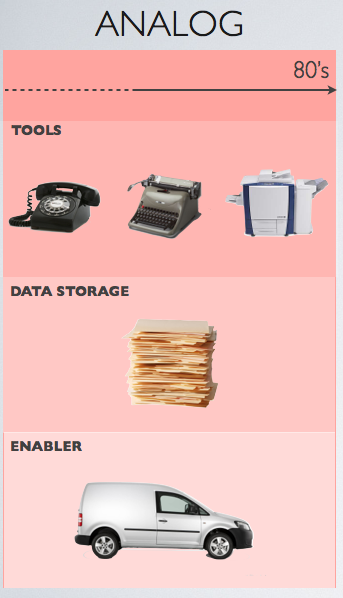In the last thirty years, information technology has had a tremendous impact on society; it affected the way people communicate, interact and do business. This transformation has to do with the advent of computers and then of telecommunication networks. In this period, the enterprise evolved, and we can identify three major periods, each one characterized by a different way to do business: the analog enterprise, the digital enterprise, and now, the connected enterprise.
 |
The Analog Enterprise Before mid-1980s, there were three major inventions that revolutionized the way companies did business and ran their operations: the telephone, the typewriter, and the Xerox photocopier. Computers and telecommunication networks had already been invented, but only a few industries, like financial institutions and universities, were using such technologies. Adoption of computing was still very limited and most business users were using older technologies, some of which had been around for over a hundred years. Documents were written on paper and stored in folders and information flowed by way of mail and courier. |
 |
The Digital Enterprise Only in the late 1980s and early 1990s did we start seeing computers becoming mainstream and appearing on office workers’ desks. Once a technology limited to executives and scientists, the personal computer is now used by ordinary people and there is no need to be a computer scientist. In these years, we saw the rise of Microsoft that becomes one of the richest and fastest growing companies in the planet. Excel and, in general, the office package became a requirement on everyone’s resume. In the digital enterprise, information was stored on hard disk drives, floppy disks, or compact discs. The processor is the new steam engine, and companies are always looking to acquire computers with the latest processor, because faster speed is a competitive advantage. During this period we also see the wider adoption another important invention, the fax machine, a technology that facilitates the flow of information. |
 |
The Connected Enterprise Telecommunication networks were first implemented during the late 1950s. However, their use was limited to the military, airline reservation systems, and research. The commercial Internet only started taking off in the mid-1990s and it wasn’t until early 2000s that we saw it becoming vital to enterprises. Networks soon became the backbone of doing business and without them, enterprises would not be able to sustain their back office operations and customer-facing services. Thanks to the network, applications and documents moved from the local computer to the cloud, making it possible to use smaller devices with limited computational and memory resources, such as tablets and smartphones. Networks’ ubiquiti made it possible for individuals and organizations to use cloud service providers for the management of data and voice applications. The storage of information is no longer on physical media but on remote data centers (also referred to “the cloud”) where, thanks to economies of scale, outsourcing data storage is more cost effective and efficient. In this new period, enterprises rely on telecommunication networks and, as we can see, investment in networking technologies is spiking. |
Enterprise WAN and Distributed Network Monitoring

The connected enterprise has increased the importance of the network infrastructure, the role network engineers, and, consequently, the adoption of network monitoring tools. Employees need to communicate with each other via emails, voice over IP calls, corporate chat applications (e.g. Slack or Microsoft Lync) to exchange documents and access outside resources and cloud applications. Remote offices are not so remote anymore, as they are all interconnected with each other via private (MPLS, SES, FR) or public (Internet + VPN tunnel) connections. More than ever before, the enterprise network group must assure a secure, reliable, and stable connection to intranet and Internet resources. On the network monitoring side, we see a strong interest in distributed network monitoring solutions, as practitioners understand that centralized monitoring tools are limited and inefficient for covering large WAN environments. NetBeez is the latest example of distributed network monitoring and we are excited to be at the forefront of a revolution in the way that companies use IT to support and grow their business.





